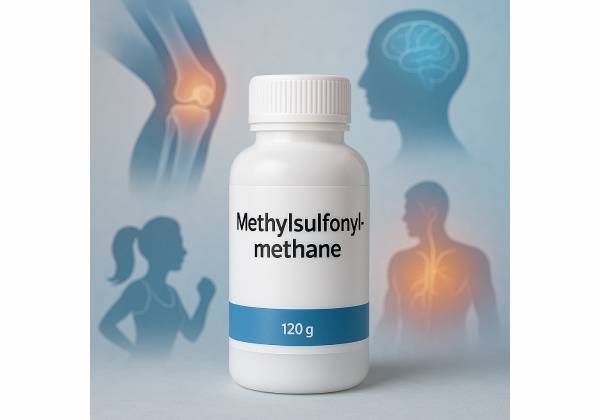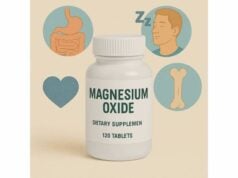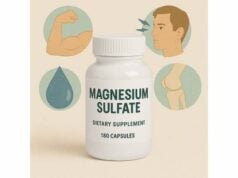
Methylsulfonylmethane—usually shortened to MSM and sometimes listed as dimethyl sulfone—is an organic sulfur compound found in small amounts in plants, fruits, and milk. As a supplement, MSM is marketed for joint comfort, exercise recovery, and skin and hair support. Research over the last two decades shows that MSM can modestly reduce joint pain and stiffness in some people, support everyday physical function, and help certain individuals feel less sore after strenuous activity. It is also generally well tolerated for short to medium durations at commonly used doses. Yet MSM is not a cure-all: benefits tend to be moderate, grow gradually over several weeks, and depend on dose, product quality, and expectations. This guide translates the science into practical steps—what MSM does, who might benefit, how to dose and time it, what to combine it with (and avoid), and how to judge whether it is working. Along the way, you will find the most common mistakes that sabotage results and a balanced look at the quality of the evidence behind MSM’s most popular uses.
Essential Insights
- Modestly reduces knee pain and stiffness in some adults after consistent use for 6–12 weeks.
- Typical daily dose ranges from 1.5–3 g/day, often divided; some studies used up to 4 g/day.
- May lessen exercise-related soreness and support everyday function; effects are subtle, not dramatic.
- Generally well tolerated; common side effects are mild GI upset or headache, especially early on.
- Avoid self-use if pregnant or breastfeeding, or if you have significant kidney or liver disease—seek clinical guidance first.
Table of Contents
- What MSM is and how it works
- Where MSM helps and where it does not
- How to take MSM: dosing and timing
- Factors that change your results
- Common mistakes, risks, and who should avoid
- Evidence today, FAQs, and action steps
What MSM is and how it works
What exactly is MSM?
MSM (methylsulfonylmethane) is a small, sulfur-containing molecule naturally present in the diet in trace amounts and produced industrially for supplements. You will also see it called dimethyl sulfone. It is odorless (unlike sulfurous compounds such as garlic’s allicin), water-soluble, and easily mixed into capsules or powders.
Why sulfur matters.
Sulfur is a building block for cysteine and methionine (amino acids), and for sulfur-rich proteins (like keratin in hair and nails). It contributes to glutathione (a crucial cellular antioxidant) and to disulfide bonds that help proteins hold their shape. MSM is not a protein source, but it delivers bioavailable sulfur, and some of MSM’s proposed benefits relate to supporting sulfur-dependent biochemistry.
Proposed mechanisms you’ll see in the literature (simplified):
- Anti-inflammatory signaling: MSM appears to influence pathways such as NF-κB and Nrf2, which can modulate inflammatory cytokines and cellular antioxidant defenses. In human settings, this likely translates to small reductions in soreness and stiffness rather than dramatic anti-inflammatory effects.
- Cartilage and connective tissue support: Cell and animal experiments suggest MSM may help chondrocyte function and extracellular matrix integrity (think collagen and proteoglycans). Human trials in osteoarthritis (OA) align with modest improvements in pain and function when MSM is taken consistently.
- Redox balance: MSM may help maintain glutathione status under stress and reduce markers of oxidative stress after hard exercise. In practice, some users report that post-workout discomfort is a bit less pronounced.
- Skin and nail structure: Keratin is rich in sulfur; MSM’s role here is biologically plausible and supported by small cosmetic studies, though the clinical significance is limited compared with skincare basics (UV protection, gentle cleansing, hydration).
How fast it works and how it is handled by the body.
MSM is absorbed in the small intestine, circulates in plasma, and is excreted in urine. Most people do not feel an acute effect. Instead, benefits typically build over weeks, with clearer signals around 6–12 weeks for joint comfort and function. That timeline mirrors many joint-support ingredients and reflects the slow biology of connective tissues and pain perception.
What MSM is not.
It is not the same as DMSO (dimethyl sulfoxide). DMSO is a different compound with different uses and regulatory status. Do not substitute one for the other. MSM is also not a stand-alone cure for arthritis or a replacement for physical therapy, strength training, or weight management—all of which have stronger, cornerstone roles in joint health.
Where MSM helps and where it does not
Osteoarthritis (especially the knee): what to expect.
Across multiple randomized trials, adults with knee osteoarthritis who took MSM (often 3 g/day to 6 g/day, commonly 1.5–3 g/day) experienced modest improvements in pain and physical function compared with placebo over 8–12 weeks. Improvements are usually small to moderate on validated scales and matter most to people who value even incremental relief for daily tasks (standing, stairs, longer walks). Responses vary: some feel clearly better, some notice only subtle changes, and a minority feel no difference.
Everyday stiffness and activity tolerance.
Outside of diagnosed arthritis, individuals with recurrent knee soreness or age-related stiffness sometimes report that MSM makes movement more comfortable. In a randomized trial of adults with mild knee pain, consistent MSM intake over 12 weeks improved knee-related quality of life and self-reported discomfort. These are quality-of-life gains, not cures, and they depend on daily use.
Exercise recovery and soreness.
MSM has been studied around endurance events and resistance training. The pattern is consistent: soreness ratings may be lower and certain oxidative stress markers may improve with MSM, but objective performance shifts are small or inconsistent. If recovery feels smoother and training adherence stays high, the value is real for you—even if the lab numbers are modest.
Skin, hair, and nails.
Because keratin depends on sulfur bonds, MSM is commonly included in beauty formulas. Small trials and user reports describe improvements in skin hydration and smoothness, sometimes when paired with collagen or silicon. These effects are supportive, not transformative; daily sun protection and a simple skincare routine still drive most outcomes.
Back pain and other musculoskeletal complaints.
Evidence is limited and mixed. Some open-label and small controlled studies suggest MSM may help nonspecific back pain or multi-joint aches, but the signal is weaker than in knee OA. If you try MSM for generalized aches, set conservative expectations and a time-boxed trial (see dosing section).
Where claims outpace evidence.
- Rapid joint repair: Connective tissue adapts slowly. MSM can support comfort; it does not rebuild cartilage on its own.
- Weight loss or metabolic changes: Human studies do not show meaningful changes in body weight or resting metabolism from MSM alone.
- Powerful anti-inflammatory: MSM’s anti-inflammatory actions are modest in humans at typical doses; do not expect drug-like effects.
Bottom line for benefits.
MSM offers incremental, habit-dependent improvements in joint comfort and activity tolerance, along with a chance of milder post-exercise soreness. Gains are most noticeable when MSM complements fundamentals: regular movement, progressive strength work, healthy body weight, and adequate sleep.
How to take MSM: dosing and timing
Standard adult dosing (evidence-aligned):
- Starting dose: 1.5 g/day (1,500 mg) for the first 1–2 weeks to assess tolerance.
- Typical range: 1.5–3 g/day, taken once or in 2–3 divided doses.
- Upper end used in studies: up to 4–6 g/day for limited durations under supervision. Many people do well at ~2–3 g/day.
- Powder vs. capsules: Powders make larger doses economical; capsules improve convenience and reduce the “mineral-like” taste.
Timing tips that matter more than people think:
- Take MSM with food if you are prone to mild nausea.
- Split the dose (e.g., 1 g morning, 1 g evening) if you experience GI upset or headache on single, larger doses.
- Be consistent. Mark your calendar for 6–8 weeks before judging MSM fairly. Joint outcomes rarely change in the first 10–14 days.
Goal-based dosing examples:
- Knee OA or recurrent knee soreness: 2–3 g/day divided, for 12 weeks, then reassess.
- Exercise recovery block (half-marathon prep or new lifting cycle): 2–3 g/day for 3–4 weeks spanning the hardest training microcycle.
- General stiffness with morning discomfort: start 1.5 g/day; if no GI issues, increase to 2–3 g/day after 1–2 weeks.
What to stack (and what to skip):
- Often paired with: glucosamine, chondroitin, boswellia, or collagen. MSM shows additive comfort benefits in some combination studies, particularly with glucosamine for knee OA.
- Neutral to cautious: high-dose curcumin or omega-3s are compatible but watch total GI load if you’re sensitive.
- Avoid piling on multiple new joint supplements simultaneously; you won’t know what worked. Add one, evaluate, then layer thoughtfully.
How to judge success (simple checklist):
Track, once weekly:
- Pain at rest (0–10).
- First-10-minutes stiffness after waking (0–10).
- Function (stairs, chair stands, walking distance).
- Rescue meds (e.g., acetaminophen or NSAIDs) used per week.
After 6–8 weeks, continue if you see meaningful improvement (e.g., ≥1–2 points less pain, less morning stiffness, easier stairs, fewer rescue doses). If not, discontinue without guilt and revisit the basics (strength training cadence, body weight, sleep).
When to pause or adjust dose:
- New GI symptoms, headache, or rash → reduce to 1–1.5 g/day or stop.
- Starting a new medication or being scheduled for surgery → inform your clinician about MSM; pause before procedures if requested.
Factors that change your results
1) Baseline activity and strength
People who combine MSM with progressive strength training (especially hip, quadriceps, and calf work for knee OA) often report better day-to-day function than those who rely on supplements alone. Muscle strength offloads joints; MSM may help you tolerate the work that actually changes outcomes.
2) Body weight and load management
Every extra kilogram adds several kilograms of force across the knee with each step. MSM can help with comfort, but weight reduction and activity pacing typically deliver larger, more durable benefits for knee pain. Use MSM to enable more movement, not to replace load management.
3) Dose consistency and duration
MSM results are habit-driven. Skipping days or abandoning the plan at week two usually yields “no effect.” Set a start date, a review date at week six, and a decision date at week 8–12.
4) Product quality
Choose a product with third-party testing for identity, purity, and contaminants (e.g., heavy metals). MSM is stable and generally safe, but dietary supplement quality varies. If you’re using larger doses or have a sensitive stomach, quality control becomes even more important.
5) Diet pattern and hydration
A diet rich in whole foods, adequate protein, and omega-3 fatty acids improves pain biology from multiple angles. Hydration also influences joint comfort and headache risk. MSM may feel more effective when these foundations are in place.
6) Expectations and what “better” means
Successful users define specific goals: fewer stairs hurt, longer walks, less reliance on rescue meds, or quicker post-workout recovery. Expect incremental gains that accumulate. If you want a fast, strong anti-inflammatory “switch,” MSM will likely disappoint.
7) Medical context
Coexisting autoimmune disease, crystalline arthritis (gout), or meniscal tears may narrow MSM’s role. It can still aid comfort, but diagnosis-specific care (urate control, injections, physical therapy, or surgery) should take precedence. Always align MSM with your overall plan.
8) Pairing with other supplements or medications
- Glucosamine/chondroitin: combination may provide additive relief in knee OA for some.
- NSAIDs or acetaminophen: can be used alongside MSM; intention is to lower reliance on these over time if comfort improves.
- Anticoagulants: while no strong interaction data exist, many clinicians prefer to monitor when any new supplement is added.
- Pregnancy/lactation: safety data are insufficient—avoid unless a clinician explicitly recommends it.
Common mistakes, risks, and who should avoid
Mistake 1: Expecting instant relief.
MSM’s typical timeline is weeks, not days. Judging at day five misses potential benefits that develop with steady use.
Mistake 2: Taking too little for too short a time.
Doses under 1.5 g/day may underdeliver for joint comfort in adults. A fair trial is 1.5–3 g/day for 6–12 weeks with adherence ≥85%.
Mistake 3: Stopping exercise because “supplements will fix it.”
MSM can make movement more comfortable. Use that window to train the muscles that protect your joints.
Mistake 4: Over-stacking.
Starting MSM, glucosamine, chondroitin, turmeric, collagen, and boswellia all at once makes it impossible to identify what worked—or what caused side effects. Add one new variable at a time.
Mistake 5: Ignoring hydration and meal context.
Most mild GI upset with MSM improves when doses are split and taken with food and water.
Side effects and tolerability
MSM is generally well tolerated. The most common issues are nausea, loose stools, bloating, headache, or a brief sense of fatigue when starting. These are typically mild and transient, resolving with dose-splitting or dose reduction. Allergic reactions are rare; stop immediately and seek care if you notice rash, swelling, or breathing difficulty.
Interactions and cautions
- Anticoagulants/antiplatelets: theoretical bleeding concerns are low but prudent monitoring is reasonable when adding any new supplement.
- Major surgery: disclose MSM; some teams ask patients to pause nonessential supplements pre-operatively.
- Kidney or liver disease: discuss MSM with your clinician first; adjust dose or avoid based on your care plan.
- Pregnancy or breastfeeding: data are insufficient—avoid unless part of a supervised plan.
- Children and adolescents: routine MSM use is not recommended unless directed by a pediatric clinician.
Who should avoid or seek medical guidance first
- Individuals with significant renal or hepatic impairment.
- Those who are pregnant, trying to conceive, or breastfeeding.
- People with unexplained joint swelling, fever, or acute traumatic injury (these need medical evaluation).
- Anyone with new neurologic symptoms or rapidly worsening pain—don’t self-treat; seek care.
Evidence today, FAQs, and action steps
How strong is the evidence for joint pain?
Multiple randomized trials in knee osteoarthritis show modest pain and function improvements with MSM over 8–12 weeks. Some combination trials (e.g., MSM with glucosamine ± chondroitin) show additive benefits. The average effect size is small to moderate, meaning some people feel worthwhile relief while others notice little. MSM is best framed as a supportive option within a broader joint-health plan.
Does MSM help exercise recovery?
In active adults, MSM can reduce perceived soreness and may influence oxidative stress markers after heavy efforts. Changes in performance are usually small. For endurance or team sport blocks, consistent MSM may improve how you feel between sessions, which can help with training adherence.
How long should I take MSM before deciding?
Give it 6–8 weeks at 1.5–3 g/day. If you reach 12 weeks without clear benefit, it is reasonable to stop. If MSM helps, some people maintain a lower “maintenance” dose (e.g., 1.5–2 g/day) and pulse higher doses during tougher training or flare-ups.
Is powder better than capsules?
Efficacy is driven by dose and consistency, not form. Powders are cost-effective for doses ≥2 g/day; capsules are convenient for travel or if you dislike the taste.
Can MSM replace NSAIDs?
Not directly. Many use MSM to reduce reliance on NSAIDs for day-to-day discomfort. Continue to follow your clinician’s guidance for NSAID use, and monitor stomach, kidney, and blood pressure considerations with any long-term NSAID plan.
What about pairing MSM with physical therapy?
That’s often the best approach. MSM can make joints feel better enough for you to complete strengthening and mobility work—the interventions most likely to improve function and reduce pain over the long term.
Quick action plan
- Choose a third-party tested MSM product.
- Start 1.5 g/day with food for 1–2 weeks; increase to 2–3 g/day if tolerated.
- Track pain, stiffness, and function weekly.
- Pair MSM with strength training 2–3 days/week, daily steps, and sleep >7 hours.
- Reassess at 8–12 weeks; continue if meaningful benefit, otherwise stop and reallocate effort to higher-impact strategies.
References
- Methylsulfonylmethane Improves Knee Quality of Life in Healthy Japanese Adults with Mild Knee Pain: A Randomized, Double-Blind, Placebo-Controlled Trial 2023 (RCT)
- Methylsulfonylmethane: Applications and Safety of a Novel Dietary Supplement 2017 (Review)
- Efficacy of methylsulfonylmethane (MSM) in osteoarthritis of the knee: a randomized controlled study 2011 (RCT)
- Effects of Methylsulfonylmethane (MSM) on exercise-induced oxidative stress, muscle damage, and pain following a half-marathon: a double-blind, randomized, placebo-controlled trial 2017 (RCT)
- Dimethyl Sulfoxide (DMSO) and Methylsulfonylmethane (MSM) for Osteoarthritis 2024 (Guidance)
Medical Disclaimer
This article is for educational purposes and is not a substitute for personalized medical advice, diagnosis, or treatment. Speak with a qualified healthcare professional before starting any supplement, including MSM—especially if you are pregnant or breastfeeding, have kidney or liver disease, take prescription medications, or plan to undergo surgery. Stop MSM and seek medical care immediately if you develop signs of an allergic reaction (rash, swelling, breathing difficulty) or experience persistent, unexplained symptoms.
If this guide was helpful, please consider sharing it on Facebook, X (formerly Twitter), or your preferred platform, and follow us for more evidence-informed wellness content. Your support helps us continue producing high-quality articles that put readers first.










